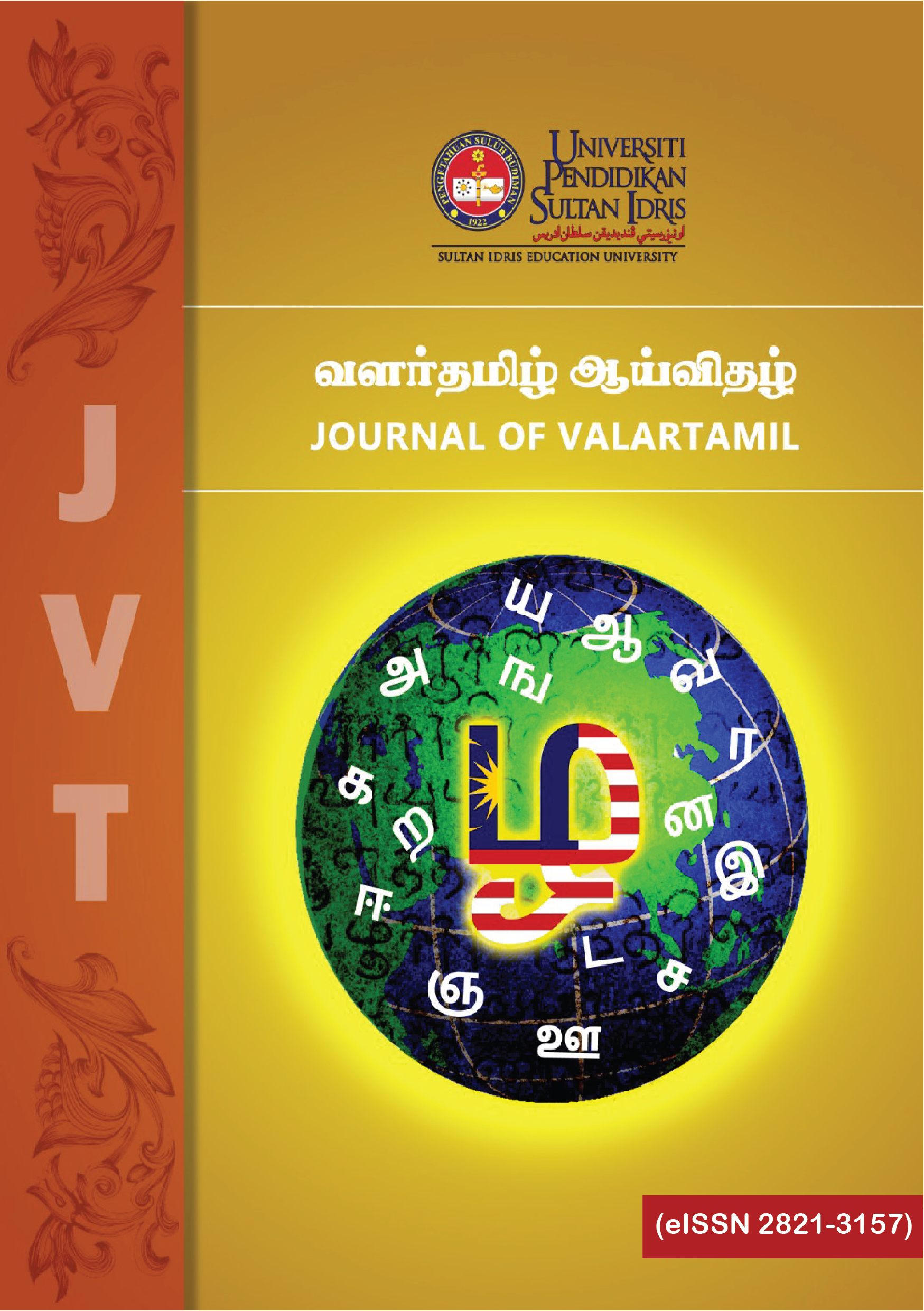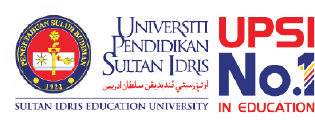கோ. புண்ணியவானின் செலாஞ்சார் அம்பாட் நாவலில் சித்தரிக்கப்பட்டுள்ள மலேசிய இந்தியத் தோட்டப்புறச் சமூகத்தின் சமூக, பொருளாதாரத் தரத்தை உயர்த்திக்கொள்வதற்கான மனப்பான்மை
Attitude of Malaysian Indian Plantation Community Towards Improving Their Socioeconomic Status as Portrayed in Selancar Ampat Novel by Ko. Punniavan
DOI:
https://doi.org/10.37134/jvt.vol2.1.4.2021Keywords:
சமூகப்பொருளாதாரத் தரம், செலாஞ்சார் அம்பாட், தோட்டப்புறச் சமூகம், மனப்பான்மைAbstract
இந்த ஆய்வின் நோக்கம் கோ. புண்ணியவானின் ‘செலாஞ்சார் அம்பாட்’ நாவலில் சித்தரிக்கப் பட்டுள்ள மலேசிய இந்தியத் தோட்டப்புறச் சமூகத்தின் சமூக, பொருளாதாரத் தரத்தை அடையாளம் காண்பது, அவர்களது மனப்பாங்கினைப் பகுத்தாய்வது மற்றும் இவ்விரண்டிற்கிடையிலான தொடர்பை ஆய்வது ஆகும். இந்த ஆய்வு ஒரு ‘தரவியல் வகை’ (qualitative method) ஆய்வாகும். ஆய்வின் நோக்கத்தை அடைவதற்கு, ‘விவரித்துப் பகுத்தாய்தல்’ (descriptive analysis) முறை பயன்படுத்தப்பட்டுள்ளது. இவ்வாய்வில் கதாமாந்தர்களின் மனப்பாங்கை பகுத்தாய்வதற்காக ‘காரண காரிய கோட்பாடு’ (Theory of Reasoned Action) பயன்படுத்தப்பட்டுள்ளது. இதற்காக, இந்நாவலிலிருந்து நேர்மறை, எதிர்மறை மனப்பாங்கைச் சார்ந்த இரண்டு கதாமாந்தர்களை வைத்து ஆய்வு நடத்தப்பட்டது. இவ்வாய்வின் வழி, மலேசிய இந்தியத் தோட்டப்புறச் சமூகத்தின் சமூக பொருளாதாரத் தரம் மேன்மையும் தாழ்மையும் கலந்துள்ளதாக அடையாளம் காணப்பட்டுள்ளது, அவர்களது மனப்பான்மை நேர்மறை, எதிர்மறை என இருவகையாகப் பகுத்தாய்வு செய்யப்பட்டுள்ளது. மேலும், இவ்விரண்டிற்கிடையில் நெருங்கிய தொடர்பு இருப்பதாகக் கண்டறியப்பட்டுள்ளது. நேர்மறை மனப்பாங்கினைக் கொண்டவர் சமூக பொருளாதாரத் தரத்தில் உயந்திருப்பதையும், எதிர்மறை மனப்பாங்கினைக் கொண்டவர் தாழ்ந்திருப்பதையும் தெளிவாகக் காண முடிகின்றது. இவ்வாய்வின் முடிவு யாதெனில், மலேசிய இந்தியத் தோட்டப்புறச் சமூகத்தின் சமூக பொருளாதாரத் தரம் அவர்களது மனப்பாங்கைப் பொருத்தே அமைந்திருக்கின்றது. இவ்வாய்வின் வழி, இச்சமூகம் பிறரைப்போல் தாங்களும் வாழ்வில் உயர வேண்டுமானால், தங்களது மனப்பாங்கை நேர்மறையாக மாற்றியமைப்பது அவசியமென்பது தெளிவாகிறது.The objectives of this research were to identify the socioeconomic status of Malaysian Indian plantation community, to analyze their attitude and to study the correlation between these two variables as portrayed in the Selancar Ampat novel. The qualitative research method was used and data collection was carried out using descriptive and analysis. The Theory of Reasoned Action was used to analyze the attitude and behavior according to 4 elements: intention, belief, reflection and behavior. Two characters with both positive and negative attitudes were chosen from the novel for this analysis. The findings show there is both high and low socioeconomic statuses and positive and negative attitudes among the characters. The findings also reveal that there is correlation between their socioeconomic status and their attitude. Those of high socioeconomic status portray positive attitude whereas the one with low socioeconomic status portrays negative attitude. The conclusion of this research is, the socioeconomic status of the Malaysian Indian plantation community is determined by their attitude. The research implies that the Malaysian Indian plantation community has to change their attitude into positive in order to enjoy high socio-economic status like others.
Keywords: Attitude, Plantation community, Selancar Ampat, Socioeconomic status
Downloads
References
Arasaratnam. S. (1979). Indians in Malaysia and Singapore. Singapore: Oxford University Press.
Basuki Gunawan & Rabeendran Raghavan. (1977). The Plight of the Plantation Workers in Malaysia. University Van Amsterdam.
Bharathi Kandasamy. (1999). The Sufferings of Indian Plantation laborers in Malaya & Ceylon before Independence. Nagercoil: Hindu College.
Icek Ajzen & Martin Fishbein. (1980). Understanding Attitudes and Predicting Behavior. New Jersey: Prentice-Hall.
Jain, Ravindra. K. (1970). South Indian on the Plantation Frontier in Malaya. New Haven: Yale University Press.
Janakey Raman Manikam . (2011). The Malaysian Indian Dilemma, Third Edition. Kuala Lumpur.
Jesuthas. (2010). Modern Tamil Literature. Kuala Lumpur: Uma Publication.
Kernial Singh Sandhu. (1969). Indians in Malaya. Cambridge.
Kumarasamy Tannirmalai. (2011). The Social Issues Portrayed by Malaysian Tamil Novels in 1990-s. Kuala Lumpur: University Malaya (Unpublished Master Thesis).
Mudzaffar Desmond Tate. (2008). The Malaysian Indian, History, problems and future. Journal of Southeast Asian Studies, 42(1), 181-184. Doi: 2307/23020314.
Ponmugam. (1997). Kalam Ingge, Kanniam Engge. Selangor, Malaysia.
Punniavan. K. (2012). Selanchar Ampat. Kuala Lumpur.
Rama Subbiah (1966). Malaysian Tamils. Kuala Lumpur: University Malaya.
Sababathy, V. (1999). Malaysia Tamil Novel Literature. Malaysia: University Malaya.
Segar Narayanan. (2010). Satu Kajian Tentang Corak Pemikiran Sosial India yang Terpapar Dalam Novel Tamil Malaysia (1957-1987). Kuala Lumpur: Universiti Malaya (Unpublished PhD Thesis).
Varatharajoo, M. (1993). Malaysia: Engge En Panggu. Chennai.
Varatharajoo, M. (2004). Erinthukondirukkum Tamizhinam. Selangor: Arivalayam.





